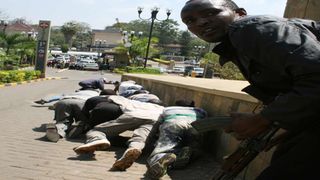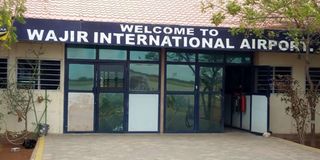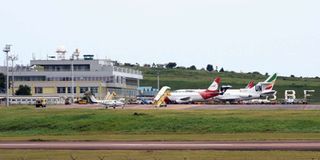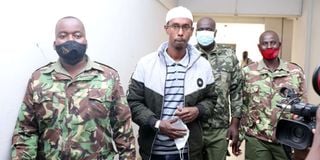
Westgate mall attack in 2013
| File | Nation Media GroupNews
Premium
Westgate terrorists: The untold story
On Monday, June 17, 2013, the East African Express flight 803 lumbered across the Mogadishu runway as it prepared to take off to Nairobi’s Jomo Kenyatta International Airport via the sun-baked Wajir International Airport. It had 52 passengers – and one was a terrorist.
Inside the Wajir airport, and even in Mogadishu’s Aden Adde International Airport, nobody seemed to notice the innocent-looking 20-year-old Mohamed Abdinur Said, passenger no. 3 in the flight manifest, wearing a light-olive green shirt, as he went through the regular security protocols.
Actually, there was nothing unusual about him: His brand new passport, number P00278810, issued a week earlier, indicated he was a student with no history of travel.
His destination, Uganda’s Entebbe International Airport, did not arouse any curiosity, either, while his thin-frame only exposed his protruding Adam’s apple. The time was 3.51 pm. It was hot outside. He wore no jacket and travelled light.
Mohamed Abdinur Said, one of the Westgate mall terrorists.
Abdinur was one of the four Westgate attackers destined for Nairobi. The Nation has been scouring thousands of pages from the Directorate of Criminal Investigation detective files, court files, and cell-phone data - to finally piece together the most comprehensive story behind the Westgate Mall attack.
Call log data indicates that as Abdinur, the lead attacker, waited for his flight in Wajir to get clearance to Nairobi, he reached his pocket and fished out his phone which then had a Somali number. He inserted a Safaricom SIM card and made three calls to, detectives say, Al Shabaab headquarters in Somalia.

The Wajir International Airport.
He also made contact with two individuals in Kenya. While one call was to a member of the Al Shabaab sleeper cell, the other was to 20-year-old Ahmed Hassan Abukar – who had already passed Wajir Airport as part of the advance terrorist party that was destined to Nairobi via Entebbe.
Ahmed Hassan Abukar, one of the Westgate terrorists.
Both Abukar and Abdinur were to meet in Kenya – and months later, as they had jarringly planned, they would die together in Westgate, Nairobi to ostensibly coerce the Kenyan troops to leave Somalia.
The two attackers knew each other since their teen days in the sprawling Kakuma Refugee camp, playing football together and – later – planning their destiny. Call logs show that the first contact was made in Wajir, then after flight 803 touched down at JKIA at 5.43 pm and after Abdinur landed in Entebbe.
Baby face
Although for years now all passengers from volatile Somalia have to alight in Wajir for security check-up after the one-hour flight from Mogadishu - these particular passengers, nay terrorists, and on three different flights - did not catch anyone’s attention.
For his part, Abdinur’s baby-face and pseudo-innocence masked his intentions. That innocence would be shattered three months later when he emerged as the leader of the Al Shabaab terrorists, who armed with assault rifles and grenades, stormed Westgate Mall in Westlands, Nairobi, on September 21, 2013, leaving 67 people dead, thousands injured and a nation wondering how it happened.
While all the attackers were killed inside Westgate Mall, including Abdinur and Abukar, the search and arrest for their accomplices in Kenya turned to be a painstaking activity as Directorate of Criminal Investigation’s detectives and analysts spent hundreds of hours tracking the accomplices - who were recently jailed.
“Terrorists leave a lot of primary and secondary data. We spent months piecing together the various parts to understand this particular attack and make arrests,” says Paul Mumo who was team leader of Westgate evidence analysis.
Mr Mumo, a US and Israeli-trained detective, was the man who made powerpoint presentation during the hearing of the Westgate trial in a tricky case that was only based on circumstantial evidence: communication frequency and patterns. The forensic analysis done in the country by Mumo and his team members was hailed later as the most comprehensive ever done in Kenya in getting terror suspects jailed.
The weak link: Entebbe Airport
Initially, it had not occurred to investigators that Entebbe Airport could be the weak-link to the Westgate attack. But the choice of Entebbe was apt. JKIA was proofing hard for terrorists to penetrate due to increased surveillance and since the facility was clamouring for a Category One Status by the Federal Aviation Administration of the United States.
At JKIA, hawk-eyed General Service Unit personnel always watched travellers’ every step – and terrorists knew it was not worth the risk.
As such Abdinur, and his colleagues, had opted to use Entebbe as their landing and board public transport which was less scrutinised at the Malaba border. It was dark in Kampala when Abdinur reached Entebbe Airport at 9.30 pm. He called Abukar.
CCTV footage from Entebbe shows a deserted airport as Abdinur went through the immigration procedure, clutching his Somali passport. It was here that a clear image of the terrorist was taken – and this was retrieved later by Kenyan detectives as they followed the trail of the attackers.

A view of Entebbe International Airport.
Two hours earlier, at 7.35 pm, another Westgate attacker the 20-year-old Ahmed Hassan Abukar had arrived on aboard another East African Express airline. He wore a suit and an ill-fitting shirt whose collar was still loose when buttoned. This gave the visibly nervous terrorist a craned-neck appearance. Once cleared at the immigration, he disappeared into Kampala to await the call from Abdinur – then flying to Entebbe.
Unlike Abukar who was to right away take a bus to Nairobi, Abdinur was to stay in Kampala for two days, manage the arrivals and departures of the attackers and then fly back to Mogadishu, albeit for a few days.
The Liban Abdulle connection
Records indicate that he stayed for two days in Kampala, and made several calls to his brother, a Kenya-based Al Shabaab contact named Liban Abdulle, who was set free by the Milimani Court but abducted shortly after by unknown people. The attacker also made a call to a South Sudan-registered cell-phone number.
As investigators found out, Liban Abdulle was a central figure in the planning of Westgate raid for after Abukar arrived in Kampala, Liban also made a call to him that night.
It would later take a DNA test on Abukar’s skeletal remains, after their final hideout was bombed, to establish the relationship between Liban and Abdinur.

Westgate Mall terror attack suspect Liban Omar leaves Milimani Law Courts in Nairobi on October 8, 2020 after he was acquitted.
Third attacker
The third attacker was Somali-Norwegian terrorist, Ali Hassan Afrah Dhuhulow who was to fly to Entebbe on July 19 in a chartered aircraft. Dhuhulow had spoken to the Nairobi contact, Liban, on July 16, 2013, which was a day before the first two attackers Abdinur and Abukar flew from Mogadishu to Entebbe.
While heading back to Mogadishu after two days in Uganda, Abdinur spent some hours at JKIA transit area on the night of July 19 before boarding a plane to Mogadishu on June 20.
Whether Abdinur and Dhuhulow met at the JKIA transit area is not known. What we know is that on the night of July 19, aboard chartered aircraft from Mogadishu, Dhuhulow landed at the Entebbe airport with little fanfare. His passport, like that of Abdinur and Abukar, yet again, indicated he was a 25-year-old student. But he was not.
Although he was travelling with a Somali passport, issued on August 7, 2012, Dhuhulow was a Norwegian citizen having grown in the seaside town of Larvik where his parents moved as refugees in 1999. Here, he attended Thor Heyerdahl High School - one of the largest upper secondary schools in Norway - and was in touch with radical groups such as the Norwegian-based Islamist group, Profetens Ummah, which translates to “Prophet’s Community of Believers”.
A 2007 photo provided by a former classmate of Norwegian-Somali Hassan Abdi Dhuhulow during a school outing in Larvik, Norway. Dhuhulow was identified as one of the gunmen who attacked Westgate mall.
Initially, the young boy wanted to be a doctor, before he was radicalised into a monster. Investigators claim that this was after visiting several Jihadist websites.
What is known is that in 2009, Dhuhulow vanished into Somalia as part of tens of Norwegian youth who desired to join the suicide infantry squad or, better still, become suicide bombers. Nairobi was giving him that chance; an opportunity to be a martyr.
Previously, Norwegian investigators found out that Dhuhulow was a frequent visitor at the Somali-run Towfiq Mosque, the largest in Norway, and located in Oslo, the capital city.
Somali-Norwegian terrorist, Ali Hassan Afrah Dhuhulow.
It was here in Oslo that the young Dhuhulow met Mohyeldeen Mohammad, an Iraqi-Norwegian Islamist, and formerly a Sharia student at the Islamic University of Madinah in Saudi Arabia, until he was deported from the country in 2011. His interest in radicalism increased and his desire to go back home, fight and die tripled.
Back in Somalia, a country he had left behind as a small boy into exile, Dhuhulow joined El Bur training camp, one of the Al Shabaab militants' main bases in the semi-autonomous region of Galmudug in central Somalia. Here, he learnt to shoot, strip an AK-47 and handle grenades.
Two months before he arrived in Kenya, he had just been released over the Mogadishu murder of a Somali radio journalist, Hassan Yusuf Absuge for what Al Shabaab said was the result of “working as a spy against Allah’s forces.”
Dressed in a blue checkered shirt and spotting a grey T-shirt inside, Dhuhulow hardly cut the image of a businessman who could charter a plane. But some minutes to 9 pm, his plane had landed in Entebbe and the pseudo-student disembarked, was cleared and vanished into Kampala enroute to Nairobi.
By now, there were two terrorists heading to Nairobi – Dhuhulow and Abukar.
Interestingly, the Entebbe airport PISCES, a border control database system largely based on biometrics, did not pick anything on them. But the photos taken by the system, and retrieved by Uganda detectives, would later aid the Kenyan investigators as they tried to unravel the story behind the raid.
-------------
On June 24, 2013 – the same day President Uhuru Kenyatta was paying his State visit to Uganda – the third Westgate terrorist, Mohamed Abdinur, who had initially returned to Mogadishu - landed in Entebbe. Kenyans were by this time much more glued to the International Criminal Court which had ruled that the cases facing Mr Kenyatta in Hague would start in November.
While security was in high alert in the previous months a government effort, starting January 21, 2013, to round up 18,000 refugees in Nairobi and hold them at Thika Municipal Stadium before dispatching them to UNHCR camps, was thwarted by the High Court which stayed the government directive dated 16th January 2013. The court decision, brought by a suit by Kituo cha Sheria, not only thwarted the security attempt to disrupt the Al Shabaab networks – mostly stationed in Nairobi’s Eastleigh, “The Little Mogadishu”.
Incidentally, on 26th July 2013, the day that Justice D.S. Majanja quashed the government directive as a “threat to the rights and fundamental freedoms”, one of the Westgate terrorists Mohamed Abdinur boarded a bus in Kampala and headed to Nairobi reaching Malaba shortly before 9am.
While in Malaba, and after clearance at the border, Abdinur contacted Abukar, the terrorist wearing a tie, and who was by now in Kenya having travelled by road from Kampala. With that, three Westgate terrorists were now already in Kenya – Mohammed Abdinur, Ahmed Hassan Abukar (the man wearing a tie) and Ali Hassan Afrah Dhuhulow, the Somali-Norwegian terrorist who had chartered a plane to Entebbe.
Only one terrorist, Yahye Ahmed Osman, was now in Somalia.
Records collected by DCI investigators show that along the way, Abdinur called Abukar and they spoke for 20 minutes during the stop-over in Eldoret from 9.25 am to 9.45 a.m. and for 30 minutes while in Nakuru. The contents of that phone conversation are unknown. He also called the Westgate attack coordinator, the Eastleigh-based Mohamed Abdi – the man who was recently jailed by Chief Magistrate Francis Andayi to 18 years for conspiracy and additional 15-year jail sentence for possession of materials promoting terrorism.
It was in Nairobi that Abdinur – believed to be the commander of the group- finally called the Somali-Norwegian terrorist, Dhuhulow, who had already reached Eastleigh: Time: 2.42 pm. The plan was to now await the arrival of the fourth terrorist, Yahye Ahmed Osman, who had been booked as Passenger No 10 to fly Air Uganda flight 203 and arrive in Entebbe at the noon of June 27, 2013. Osman was to join the rest in Eastleigh on the morning of June 28.
The engineering student
It was in Eastleigh where an engineering graduate from the Jomo Kenyatta University of Agriculture and Technology Shaykh Ahmad Iman Ali, a Jihad of Kamba and Meru parentage, had founded Al-Hijra with its base in Majengo slums.
Previously known as Muslim Youth Centre, a secret recruitment outfit for Al Shabaab, Al-Hijra was also linked by security agents to the Pumwani Riyadha Mosque, one of the oldest institutions in Nairobi, and which was run by Pumwani Riyadha Mosque Committee (PRMC).
It was this Committee that used to finance the activities of Muslim Youth Centre from money generated from rent payments from second-hand clothing stalls in the nearby Gikomba market. MYC had formally joined Al Shabaab on January 10, 2012, nearly three months after Kenyan troops were deployed to Somalia.
The four terrorists were later linked to this Al-Hijra group whose main task was to send funds and recruits to Somalia while operating madrassa classes.
With the four settled in Eastleigh, they used two fake identity cards to register new mobile phone numbers after destroying the previous numbers, according to investigators.
During the day, they would attend the gym, and some of the receipts were found inside the abandoned car at Westgate. They would also travel to Kakuma and Mombasa, while attending some madrassa classes.
Eastleigh offered a perfect hideout for the four attackers. From here they started plotting.
Tomorrow: Read about how the terrorists settled in Nairobi, and about their tailor.





